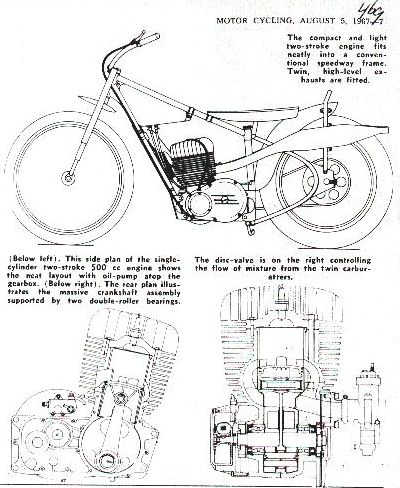



(Article taken from "Motor Cycling", August 5th, 1967)
It's been a long hard battle, but now the big two-strokes have virtually banished the traditional four-strokes from the 500cc class of international Moto-Cross. So how long will it be before a "Stroker" ousts the JAP and ESO engines from the top of the tree on the speedway, grass tracks and sandtracks of Europe ? Not long if a design drawn up by Olav Aaen, a young Norwegian engineer with speedway racing experience, is as successful as he thinks it will be.
The basic thinking behind the project is that a two stroke is lighter than a four stroke for a given capacity because of its simplicity of design no heavy valve gear - and it is "shorter", resulting in a lower centre of gravity. Both are important factors for track racing. And with cool running Alcohol fuels permitted for this type of racing, the problem of overheated pistons - the Achilles Heel of the big single cylinder two stroke - should not prove insurmountable especially considering the tremendous strides made in the development of piston material within the last few years.
Aaen's design is for a disc-valve, single cylinder engine with twin carburetors. The bore and stroke are 88mm x 82mm giving a capacity of 498cc.
A separate lubrication system looks after the main bearings, the big-end and disc valve with surplus oil from the big-end helping to lubricate the cylinder walls. Primary transmission is by gears to a totally enclosed clutch. For speedway racing, a countershaft with a single speed is fitted but provision is made in the crankcase casting for fitting a two or three speed gearbox for other forms of sport.
Twin, high-level exhaust systems with expansion chambers are fitted, the exhaust ports being to the rear wall of the cylinder. The frame follows conventional speedway lines with the engine as a stressed member. Oil for the lubrication system is contained in the vertical frame member behind the power unit. Because the engine is more compact than the four-strokes now in use, it can be carried slightly higher, and the machine can be laid over further - important because the only braking that can be done on a speedway bike is by laying it over and sliding it into a corner.
This is doubly important for a two-stroke because it is realised that the Stroker will not give the braking effect of a four-stroke when it is shut off for a bend. The motor has five transfer ports - two each side plus the third opposite the exhaust port which was originally developed by MZ and which has done so much to improve the performance of road racing two-strokes. Running on methanol, it is expected by the designer to give close to 60bhp at 7,000rom. And with the engine unit weighing considerably less than the conventional JAP and ESO units, Aaen reckons he's on to a winner.